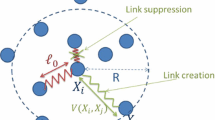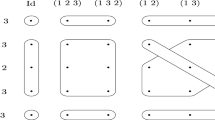Abstract
The application of the method of dimensionality reduction is, of course, limited to the spatial scales for which continuum mechanics can be used. Every practical application using the method will lose its validity even earlier, due to the finite spatial resolution of the surface topography. Therefore, it begs the question of whether the interactions on even smaller scales can be summarized into a microscopic “contact law” or “law of friction,” so that also the properties of the smallest possible scale can be taken into account in the simulation. In this chapter, we explain how the limitations of the finite spatial resolution can be eliminated by the introduction of a “microscopic” nonlinear stiffness.
Access provided by Autonomous University of Puebla. Download chapter PDF
Similar content being viewed by others
Keywords
These keywords were added by machine and not by the authors. This process is experimental and the keywords may be updated as the learning algorithm improves.
15.1 Introduction
The application of the method of dimensionality reduction is, of course, limited to the spatial scales for which continuum mechanics can be used. Every practical application using the method will lose its validity even earlier, due to the finite spatial resolution of the surface topography. Therefore, it begs the question of whether the interactions on even smaller scales can be summarized into a microscopic “contact law” or “law of friction,” so that also the properties of the smallest possible scale can be taken into account in the simulation. A complete method can only exist after the coupling to the macroscale as well as to the microscale has been accomplished. In this chapter, we explain how the limitations of the finite spatial resolution can be eliminated by the introduction of a “microscopic” non-linear stiffness.
15.2 Non-Linear Stiffness on the “Microscale”
Let us consider the classical Hertzian problem: a rigid sphere with the radius R is pressed into an elastic half-space with the effective modulus of elasticity of E *. This problem can be expressed by an equivalent one-dimensional contact between a rigid sphere with the radius \( R_{1} = R/2 \) and the linearly elastic foundation with the stiffness per unit length \( E^{*} . \) The dependence of the force on the indentation depth is given by the Hertzian Eq. (3.13). However, this is only valid if the contact radius is much larger than the discretization step size \( \Delta x \) of the linearly elastic foundation. As soon as only one spring is in contact, the stiffness is constant and the result deviates from that of the Hertzian equation. In order for the force-indentation depth relation to remain correct also at smaller forces, the discretization step size can always be chosen to be smaller. An alternative solution is based on the idea that the single spring is assigned a non-linear stiffness. The introduction of non-linear stiffness for the simulation of processes on the microscale is not a new idea. For example, this idea was used in [1] and [2] and is the foundation of the concept of “interfacial stiffness,” which is currently being used actively by many experts in the field of contact mechanics [3–5].
As explained in Sect. 10.8, a completely fractal surface can be replaced (in the sense of an average contact stiffness) by a single non-linear spring. This idea does not have to be applied to the entire system, but can also be used beginning at a certain scale. We illustrate this idea using two examples: The Hertzian contact and the contact with a randomly rough, fractal surface.
15.3 Coupling with the Microscale Using the Example of the Hertzian Contact
Here, we consider the case of the Hertzian contact, meaning the indentation of a paraboloid. As seen in Chap. 3, the original radius R is replaced in the one-dimensional model by \( R_{1} = R/2 . \) In this way, we obtain the form of the indenter:
As soon as the indentation depth decreases beyond a critical value \( u_{z}^{(0)} = g\left( {\Delta x} \right), \) only a single spring is in contact. Here, the dependence of the stiffness on the indenter form loses its validity and assumes the behavior of a single spring. If we now change the linear force law of a single spring to that effect so that each of them reproduces the asymptotic Hertzian behavior, then this problem can be avoided. So, we replace the local linear spring behavior with the following non-linear law for the spring force:
For large values of \( u_{z,i} , \) the limiting case of the standard linearly elastic foundation results. Figure 15.1 shows the force–indentation depth relationship in the transitional domain of the standard model of linear springs in blue and with the spring behavior from Eq. (15.2) in green. The force with respect to the indentation depth is now correctly given for both very large and very small forces, regardless of the size of the discretization step \( \Delta x . \) In the domain where only one spring is in contact, there is a small irregularity that cannot be avoided. As we will see in the next section, this procedure works much better for randomly rough surfaces, because small irregularities due to statistical scatter are “averaged out.”
Dependence of the force on the indentation depth plotted logarithmically: the exact solution of the Hertzian problem, results of the classical one-dimensional equivalent system with a discretization step size of \( \Delta x \), and the results for the one-dimensional equivalent model with a stiffness according to (15.2)
15.4 Coupling with the Microscale for the Case of a Randomly Rough, Fractal Surface
In Chap. 10, we have investigated fractal surfaces and seen that they follow a power law for asymptotically small forces (or indentation depths). For a fractal surface with a length L and a roughness h, the force as a function of indentation depth is determined according to Eq. (10.48):
We obtain the critical indentation depth when the stiffness corresponds exactly to that of a single linear spring. According to this, the following results from (10.30):
From this, it follows that
Insertion into (15.3) results in the critical indentation depth
In order to correctly map the asymptotic behavior, the force of a single spring, for small indentation depths, has to be defined accordingly to (15.3) while for larger indentation depths, a linear behavior should be valid. Accordingly, we define
Figure 15.2 shows, analogously to Fig. 15.1, the curve of the normal force with respect to the indentation depth for the linear standard model (dotted blue line) and with the definition of the single spring according to (15.7). The expected approximation in the domain of asymptotically small indentations (10.48) is shown as a dotted line.
Dependence of the force on the indentation depth plotted logarithmically for fractally rough lines. Approximate numerical solution for the average of many surface realizations according to Eq. (15.3), numerical results using the reduction method and the reduction method with a non-linear spring behavior according to Eq. (15.7). The bend in the blue curve for small indentation depths can be corrected using the non-linear spring behavior. Data from the plot are N = 2,049, H = 1
We have seen that the behavior on the microscales can be “coupled” to the reduction method by allowing a single spring to behave non-linearly in the domain of small indentations. In addition to the possibility of reducing the discretisation step to account for known problems, this procedure can also be used to integrate models below the scales of continuum mechanics, or to represent a cut-off domain of shorter wavelengths. Surface spectra that exhibit such a cut-off are microscopically smooth below this wavelength. This means that they form effectively the smallest possible asperities with a characteristic radius of curvature so that the Hertzian behavior can be used, as in Eq. (15.2).
References
M. Ciavarella, S. Dibello, G. Demelio, Conductance of rough random profiles. Int. J. Solids Struct. 45, 879–893 (2007)
K. Willner, Kontinuums- und Kontaktmechanik: Synthetische und analytische Darstellung (Springer, Berlin, 2003), p. 560
C. Campana, M.H. Müser, Phys. Rev. B 74, 075 420 (2006)
S. Akarapu, T. Sharp, M.O. Robbins, Phys. Rev. Lett. 106, 204301 (2011)
C. Campana, B.N.J. Persson, M.H. Müser, Transverse and normal interfacial stiffness of solids with randomly rough surfaces. J. Phys.: Condens. Matter 23, 085001 (2011)
Author information
Authors and Affiliations
Corresponding author
Rights and permissions
Copyright information
© 2015 Springer-Verlag Berlin Heidelberg
About this chapter
Cite this chapter
Popov, V.L., Pohrt, R., Heß, M. (2015). Coupling to the Microscale. In: Method of Dimensionality Reduction in Contact Mechanics and Friction. Springer, Berlin, Heidelberg. https://doi.org/10.1007/978-3-642-53876-6_15
Download citation
DOI: https://doi.org/10.1007/978-3-642-53876-6_15
Published:
Publisher Name: Springer, Berlin, Heidelberg
Print ISBN: 978-3-642-53875-9
Online ISBN: 978-3-642-53876-6
eBook Packages: EngineeringEngineering (R0)






